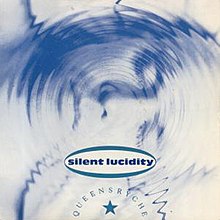Silent Lucidity
| "Silent Lucidity" | ||||
|---|---|---|---|---|
 | ||||
| Single by Queensrÿche | ||||
| from the album Empire | ||||
| Released | February 1991 | |||
| Recorded | Spring 1990 | |||
| Genre | ||||
| Length | 5:47 | |||
| Label | EMI America | |||
| Songwriter(s) | Chris DeGarmo | |||
| Producer(s) | Peter Collins | |||
| Queensrÿche singles chronology | ||||
| ||||
"Silent Lucidity" is a power ballad[5][6] by the band Queensrÿche from the 1990 album Empire. The song, which was composed by lead guitarist Chris DeGarmo, was the biggest hit for the band, peaking at #9 on the Billboard Hot 100[7] and at #1 on the Billboard Album Rock Tracks chart.[8] "Silent Lucidity" was also nominated in 1992 for the Grammy Awards for Best Rock Song and Best Rock Vocal Performance by a Duo or Group.[9]
Background
[edit]Guitarist Chris DeGarmo was inspired to write the song by the 1974 book "Creative Dreaming" by Patricia Garfield, which explained how to tap into one's subconscious to experience a lucid dream.[10]
DeGarmo noted in an interview that the average person spends 4 1/2 years of their life in a vivid hallucination state during dreaming. During that time, they can do superhuman feats like flying and walking through walls, as well as experience incredible physical sensations. "We created a very real dreamlike landscape for this song. Everything from the vocal delivery to the orchestration, to the melody, the instruments, it’s all trying to create this very lush landscape. It’s a huge-sounding track," he said.[11]
The song was originally only acoustic guitar and vocals, but additional instrumentation was added during the last week of working on the album. The album's producer was adamant that the song should not be included on the record, but the band members pushed for its inclusion.[12]
Track listing
[edit]Original 1991 release
[edit]- "Silent Lucidity" – 5:49
- "The Mission" [Live] – 6:17
- "Eyes of a Stranger [Live] – 8:03
Chart performance
[edit]Weekly charts
[edit]| Chart (1991–92) | Peak position |
|---|---|
| Canada RPM[13] | 7 |
| UK Singles (OCC)[14] | 18 |
| US Billboard Hot 100[15] | 9 |
| US Mainstream Rock (Billboard)[16] | 1 |
Year-end charts
[edit]| Chart (1991) | Position |
|---|---|
| Canada Top Singles (RPM) | 69[17] |
| US Top Pop Singles (Billboard) | 82[18] |
Personnel
[edit]- Geoff Tate – lead vocals, keyboards
- Chris DeGarmo – lead guitar, backing vocals
- Michael Wilton – rhythm guitar
- Eddie Jackson – bass, backing vocals
- Scott Rockenfield – drums
Additional personnel
[edit]Accolades
[edit]| Publication | Country | Accolade | Rank |
|---|---|---|---|
| Classic Rock | US | The 40 Greatest Power Ballads[5] | 36 |
| Glide Magazine | US | Favorite Hair Metal Power Ballads[19] | 6 |
| VH1 | US | Greatest Power Ballads[6] | 21 |
See also
[edit]References
[edit]- ^ Boehm, Mike (June 27, 1997). "Metal and Its Byproducts : Queensryche Upgrades the Machinery Without Undergoing a Retrofit or Total Conversion". Los Angeles Times. Retrieved February 24, 2021.
- ^ Jurek, Thom (August 20, 1990). "Queensryche - Empire - Album Review". Allmusic. Retrieved September 18, 2023.
- ^ Criblez, David J. (November 11, 2016). "Three lead singers take LI solo flights". Newsday. Retrieved June 28, 2021.
- ^ Erlewine, Stephen Thomas. "Queensrÿche | Biography & History". AllMusic. Retrieved February 2, 2021.
- ^ a b c "The 40 Greatest Power Ballads". Classic Rock. February 14, 2015.
- ^ a b "Greatest Power Ballads". VH1.com. MTV Networks. Archived from the original on November 13, 2006. Retrieved August 7, 2020.
- ^ "Billboard Hot 100". Billboard. Retrieved 2021-06-25.
- ^ Whitburn, Joel (2004). The Billboard Book of Top 40 Hits (8th ed.). Billboard Publications. p. 514.
- ^ "34th Grammy Awards — 1992". Rock on the Net.com. Retrieved May 7, 2012.
- ^ Dome, Malcolm (June 15, 2022). "How a book on dreams inspired Queensryche's biggest ever hit single". Louder. Retrieved June 8, 2023.
- ^ Miller, Gerri (December 1990). "Queensrÿche build an empire". Metal Edge. Retrieved June 8, 2023.
- ^ MacIntosh, Dan (November 29, 2012). "Queensrÿche founder Geoff Tate : Songwriter Interviews". Songfacts. Retrieved June 8, 2023.
- ^ "RPM Top 100 Singles - June 8, 1991" (PDF). collectionscanada.gc.ca.
- ^ "Queensryche: Artist Chart History". Official Charts Company. Retrieved February 21, 2021.
- ^ "Queensryche Chart History (Hot 100)". Billboard. Retrieved February 21, 2021.
- ^ "Queensryche Chart History (Mainstream Rock)". Billboard. Retrieved February 21, 2021.
- ^ "RPM 100 Hit Tracks of 1991". RPM. 17 July 2013. Retrieved November 23, 2017.
- ^ "1991 The Year in Music & Video: Top Pop Singles". Billboard. Vol. 103, no. 51. Nielsen Business Media. December 21, 1991. p. YE-14.
- ^ "The B List: Favorite Hair-Metal Power Ballads". GlideMagazine. 4 January 2007. Retrieved 2023-06-07.
External links
[edit]- Video clip on YouTube.
- Silent Lucidity at Discogs (list of releases)
| Studio albums | |
|---|---|
| Unofficial album | |
| EPs | |
| Live albums | |
| Compilation albums | |
| Videography | |
| Singles | |
| Concert tours | |
| Related | |
Text is available under the CC BY-SA 4.0 license; additional terms may apply.
Images, videos and audio are available under their respective licenses.
